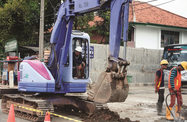Sustained foreign direct investment has been flowing into Papua New Guinea’s (PNG’s) real estate sector ever since the $15.7bn ExxonMobil-led liquefied natural gas (LNG) project was announced. In just five years, development within the sector has surpassed total development of the past 15 years, transforming the once peripheral real estate market into one of the region’s best-performing sectors. However, such growth has come at a cost.
New investments, disproportionately favouring high-end residential and commercial properties offering the highest returns, have ultimately exacerbated the pre-existing shortage of affordable housing. Rent for upmarket units, for example, have more than doubled in just four years to between PGK5500 ($2629) and PGK8000 ($3824) per week. This has led to a migration into shantytowns and informal housing settlements across the country, and rocketing construction costs have further eroded investor interest in lower-market rungs.
While this was perhaps unsurprising, given the lucrative returns of 10-15% for high-end residential developments, with the LNG project’s construction scheduled for completion in 2014, fears of a property bubble are threatening to become a reality in key urban locations. This could see the real estate market return to PNG’s latent mass market, which should serve to benefit the country as a whole.
PNG’s most-prolific property investors, superannuation firms NASFUND and Nambawan Super, saw record losses in 2011, largely attributed to peaking property values and demand. Given NASFUND’s seven-fold slump in profits from PGK308.6m ($147.49m) in 2010 to PGK44.6m ($21.32m) in 2011 and Nambawan Super’s 11-fold drop from PGK263m ($125.7m) to PGK24m ($11.47m) in the same period, it came as little surprise when the IMF raised its own warning flags in May 2011, noting that exposure to potential corrections in the property market – particularly in Port Moresby and Lae – constituted key market risks for banks and authorised superannuation funds.
Meanwhile, Ian Clyne, the managing director and CEO of Bank South Pacific (BSP) PNG, reported signs of an overheating market in August 2011, as the bank revealed a trebling of real estate lending in Port Moresby alone to PGK906.8m ($433.42m) in the past five years. While developers remain ambitious, investors are heeding the warning signs and have become increasingly cautious, responding to the influx of supply with softer rental demands, as rental prices drop toward PGK4500-5000 ($2151-2390).
Meanwhile, according to Australia-based LJ Hooker Real Estate, one-third of Port Moresby’s population, including almost 50% of the middle-class work-force, is affected by housing shortages, meaning there is further potential for growth in PNG’s economy, particularly in the lower and middle-class real estate segments.
A widely anticipated reduction in construction costs post-2014 may help realise the sector’s nascent potential, with assistance from both public and private sectors. The fledgling Office of Urbanisation’s ambitious blueprints to provide affordable housing nationwide could provide the necessary catalyst for change.
Some 27 cities and urban centres, including five designated “mega-cities”, with projected populations of over 1m people, including Port Moresby, Lae, Wewak, Tari and Kokopo, have been earmarked for urban renewal and expansion under the “National Urbanisation Policy 2010-30”.
Two affordable housing pilot developments are already underway in Port Moresby’s Torama Valley and Goroka Valley, located in the Central Highlands. However, their success is tied to private sector collaboration, following the effective collapse of the state-mandated National Housing Corporation (NHC) in the 1980s.
While this segment has yet to fully capture the attention of developers, there are some who have taken notice. For example, CB Builders, a local construction firm, established a pre-cast concrete housing production operation at their Motukea Island facility earlier this year.
“Given the cost of land, roads and associated infrastructure, we have come to the conclusion that horizontal housing is simply not affordable to the mass market. Accordingly, CB Builders is exploring the development of three- or four-storey housing units for PNG’s real estate market,” explained David Tilby, the director of Australia-based Costplan Services, a consultant to CB Builders.
As PNG’s real estate market faces an inevitable price correction in the coming years, the availability of more affordable housing for the lower and middle-income segments should increase.

